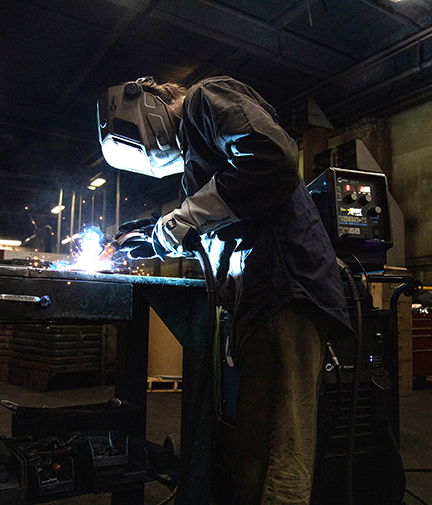Metal-Cored Wire: Busting Common Myths
Metal-cored wire isn’t new to the industry, but many are still unfamiliar with the technology. Because of this, there are often misconceptions about how it operates, especially compared to solid wire, and the cost associated with the product. Let’s bust five myths about metal-cored wire.
Myth No. 1: Metal-cored wire is only for semi-automatic welding.
Metal-cored wire actually performs well in robotic welding applications, too. The wire’s tubular design produces a broad penetration profile, offering greater tolerance for part fit-up and gap handling than solid wires. This feature can compensate for inaccurate stampings or offset tooling in robotic welding applications.
Metal-cored wire can also provide faster travel speeds and higher deposition rates than solid wire, which adds to the high level of productivity companies seek from their robotic welding systems.
High weld quality is another benefit of metal-cored wire. It has a smooth, wide bead appearance and offers excellent mechanical properties, as well as producing little to no spatter. Since uptime is key in robotic welding applications, the reduction in post-weld cleanup of spatter makes for faster production.
Myth No. 2: Metal-cored wire costs more so it increases expenses in the welding operation.
Per pound, metal-cored wire typically costs more than other solid wire. However, its attributes can actually reduce overall costs in a welding operation.
Metal-cored wire can aptly weld through dirt, oil and mill scale, and it produces very little spatter. As a result, the wire can eliminate non-value-added activities in the welding operation — both pre- and post-weld. Non-value-added activities are those that don’t contribute to throughput and include grinding, chipping, sandblasting and applying anti-spatter compound. Being able to skip these activities makes it possible for companies to reduce their costs for labor and supplies. In some cases, companies can reallocate labor to other parts of the welding operation to take on tasks that increase productivity.
The faster travel speeds and higher deposition rates provided by metal-cored wire also make it possible to produce more parts in less time, increasing overall revenue.
Myth No. 3: Metal-cored wire can’t be used for pulsed MIG welding.
Welding operators can gain the same forgiveness, ease-of-use and high deposition rates from pulsed MIG welding with metal-cored wires as when welding flat and horizontal with a CV power source. For out-of-position welding with metal-cored wire, pulsing is actually necessary to maintain control of the weld pool.
Today’s welding power sources feature sophisticated pulsed wave capabilities, making it possible to maintain a stable arc and achieve consistent weld quality with metal-cored wires.
Myth No. 4: Metal-cored wire has different strength properties than solid wire.
Typical metal-cored wire and a solid wire are classified under the same American Welding Society (AWS) standard, providing the same minimum tensile and yield strength, as well as the same elongation and Charpy V-notch (CVN) impact properties. For example, a metal-cored wire with an AWS E70C-6M classification and an AWS E70S-6 solid wire are both classified under A5.18: Specification for Carbon Steel Electrodes and Rods for Gas-Shielded Arc Welding. Because the wires are formulated and tested to this specification, both meet the AWS minimum tensile strength requirements of 70,000 psi and yield strength minimum of 58,000 psi. They offer the AWS minimum of 22% elongation and CVN impacts of 20 ft-lbs (27 Joules) at -20 degrees Fahrenheit.
Myth No. 5: Metal-cored wire is harder to weld with than solid wire.
In semi-automatic applications, welding operators will notice that metal-cored wire welds faster than solid wire. That doesn’t mean that it’s more difficult to operate. The overall technique of welding with metal-cored wire is the same as solid wire in terms of torch angles. A 10- to 15-degree push angle is a good starting point.
Metal-cored wire also provides greater forgiveness in some aspects of the welding process compared to solid wire. For example, the wider arc cone allows for slight variations in joint placement without sacrificing weld quality, making it easier for new or less skilled welding operators to put down quality welds. Welding operators can make larger beads without the need to weave or manipulate the welding gun or weld pool. It’s also possible to use longer welding wire stickouts. The contact-tip-to-work distance can be longer — usually between 1/2 inch and 1 inch, depending on wire diameter. Finally, the wider arc cone allows for greater tolerance of gaps and poor part fit-up, reducing the chances of burning through the base material.
Parting thoughts
In the right applications, metal-cored wire can provide high weld quality and productivity. It excels at welding parts prone to burn-through and instances of poor part fit up, for example. It’s also a good option for welding operations struggling to train less skilled welders, since it’s easy to use. And, it’s a good alternative to solid wire when welding on 1.5 mm and thicker steel. As with any welding wire technology, contact a trusted filler metal manufacturer or welding distributor with any questions about metal-cored wire.



